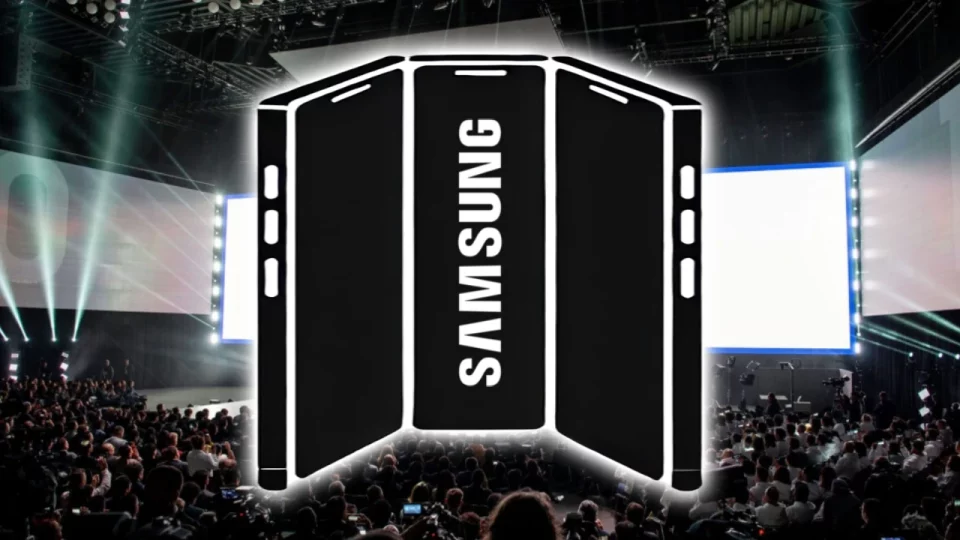For years, Samsung has been a dominant player in the foldable smartphone market, defining the segment and leading the charge with innovative designs. However, with Chinese manufacturers like Huawei and Xiaomi rapidly catching up—and in some cases, outpacing Samsung in terms of sales and features—the South Korean tech giant seems ready to take a bold leap forward.
Recent reports suggest that Samsung is working on a tri-folding smartphone, a concept poised to redefine what foldable devices can achieve.
Table of Contents
The Tri-Fold Concept
Samsung’s rumored tri-folding device represents an evolution from the current foldable designs. Unlike the book-style Galaxy Z Fold series or the clamshell Galaxy Z Flip, the tri-fold device introduces a more complex mechanism, featuring a dual-fold hinge system. This design allows the screen to fold into three sections, offering versatility in form and function.
According to a report from Korean publication ET News, Samsung’s tri-fold will use an “infolding” mechanism. This means that the two folding panels will fold inward, protecting the screen when the device is closed. Such a design aligns with Samsung’s focus on durability, a crucial factor for foldable devices that are inherently more vulnerable to wear and tear.
📲Key Specifications: Bigger, Better, and More Versatile
One of the most exciting revelations about Samsung’s tri-fold smartphone is its display dimensions. When fully unfolded, the device is expected to feature a screen size of 9-10 inches, making it significantly larger than the 7.6-inch display of the Galaxy Z Fold 6. This size places it squarely in the territory of tablets like the iPad or medium-sized Android slates, offering an immersive viewing experience for multitasking, media consumption, and productivity.
When folded, the device will shrink into a rectangular form factor, resembling a standard smartphone. This dual functionality—combining the portability of a phone with the expansive screen real estate of a tablet—highlights the potential for tri-fold devices to cater to a broader range of user needs.
Samsung’s move to a larger display also reflects the growing demand for devices that can serve multiple purposes. A tri-fold smartphone could replace a phone, tablet, and even a laptop for some users, making it an attractive option for professionals, gamers, and content creators alike.
Staying Ahead of Huawei and Apple
Samsung’s venture into tri-fold technology isn’t happening in a vacuum. The foldable market is becoming increasingly competitive, with Huawei, Xiaomi, and even Google entering the fray. Huawei, in particular, has been aggressive in challenging Samsung’s dominance, offering devices like the Mate X2 and the Mate X3 with unique features and improved designs.
Apple, though yet to enter the foldable market, is another looming competitor. Industry rumors suggest that Apple is exploring foldable technologies, and a tri-fold device from Samsung could help the company preemptively differentiate itself from whatever Apple brings to the table.
Samsung’s focus on tri-fold devices is not just about maintaining market leadership; it’s also about setting new standards. By introducing a new form factor, Samsung can expand its product line and appeal to a broader audience, solidifying its reputation as an innovator in the smartphone industry.
🛠️Challenges of a Tri-Folding Device
While the concept of a tri-fold smartphone is exciting, it comes with significant challenges. The most obvious hurdle is the engineering complexity of a dual-hinge system. Creating a mechanism that is both durable and reliable will be critical to the device’s success. Foldable hinges are already a point of vulnerability in existing devices, and adding another hinge increases the potential for mechanical failure.
Another challenge is the display itself. Foldable screens are made from flexible materials that are prone to creasing and scratching. A tri-fold device, with its larger and more complex display, will need advancements in materials science to ensure durability and longevity.
Battery life is another concern. A larger screen demands more power, and the tri-fold design leaves less internal space for a battery. Samsung will need to innovate in battery technology or optimize software to ensure the device can last through a full day of use.
Lastly, cost is a significant factor. Foldable smartphones are already expensive, and the added complexity of a tri-fold design is likely to drive prices even higher. Samsung will need to strike a balance between offering cutting-edge technology and maintaining a price point that is accessible to a broad audience.
What the Tri-Fold Means for Users
For users, a tri-fold smartphone offers several potential benefits:
- Enhanced Multitasking: With a larger screen, users can run multiple apps simultaneously, making the device ideal for productivity.
- Improved Media Experience: The expansive display is perfect for watching videos, playing games, or browsing content.
- Portability Meets Functionality: By folding into a compact form, the device retains the portability of a smartphone while offering the functionality of a tablet.
- Future-Proof Design: A tri-fold device signals a new era of innovation, appealing to early adopters and tech enthusiasts.
